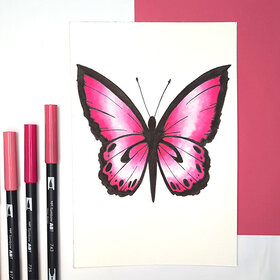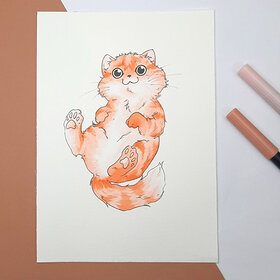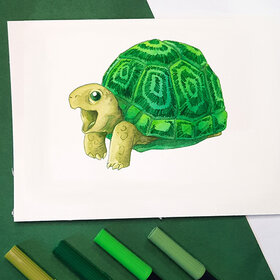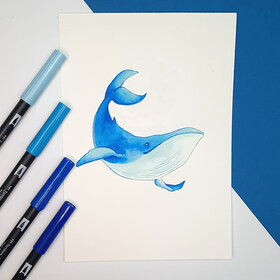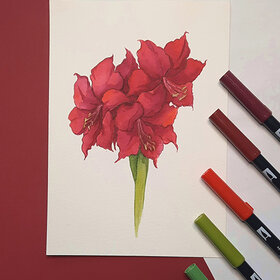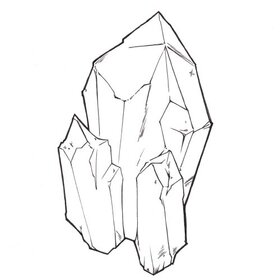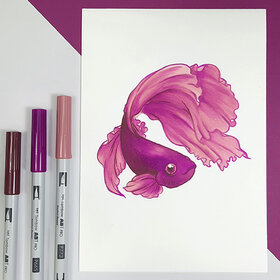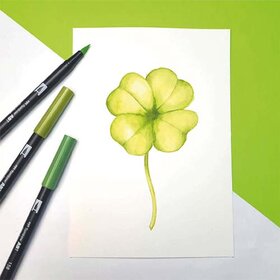Painting the modern watercolor
Watercolours enchant with their special way of painting.They have transparent or semi-transparent colours that enable effective shading and mixes. Read on for ideas relating to watercolouring. However, if you’re already familiar with the principles, you can have a look now through the various techniques or in our magazine for inspiring instructions and tips and tricks.
What exactly is watercoloring?
The term ‘watercoloring’ has been appearing more and more frequently on social networks and in the do-it-yourself (DIY) corner of bookstores for some time now. It usually refers to a modern interpretation of watercolour painting. It is less about creating an entire painting and more about using water-based colours for style elements or small illustrations such as flowers, plants and animals. There is also another factor that makes watercolouring so popular – it isn’t perfect. On the contrary: watercolor illustrations are mainly reduced to the essentials and are not a truthful version of reality. A similar technique is used for sketchnotes. This makes it very easy to learn, particularly for beginners. In just a few brush strokes, you can create effective illustrations.
Water-based paint? Watercolour paint? – What’s the difference?
Water-based paint is a dye mixed with binders. It is water soluble and is therefore applied mixed with water to create a translucent effect. Watercolour paints are part of the water-based colour family but are often lighter and more transparent than e.g. gouache. With a little water, the colours with water-based dyes dissolve out of their original form and blend to create something completely new.
Whether watercolouring or watercolour painting – no two works are ever the same or can be copied exactly and are therefore highly individual. Each watercolouring work is absolutely unique as you can never reproduce the colour gradients a second time. This is exactly what makes watercolouring interesting. It is always just a little bit different. Always new. Always creative. In this way, you discover new shapes and combinations almost by chance.
There are of course also complex illustrations where it is advisable to master a few basic techniques. However, it is suitable for everyone, whether beginner or more advanced.
Images are often complemented with lettering or lettering complemented with watercolour elements. Alternatively, the lettered word itself can be comprised of letters in watercolours, i.e. watercolour lettering. Sometimes individual elements are subsequently given a contour using a thin fineliner such as the MONO drawing pen 01, whereby the contrast gives the fine transparent painting additional intensity.
The paint
In addition to classic watercolor paints whereby the dyes are first dissolved with water similar to watercolors, there are also watercolor wood pencils and felt-tip markers such as the ABT Dual Brush Pen that can be used for watercolor painting. The latter has the advantage that it is not limited to one watercolor technique, but can be used flexibly from project to project. Water-based felt-tip markers are particularly suitable for beginners, as they do not have to be used exclusively for watercoloring and can therefore be used to see whether you enjoy watercoloring or not without any risk.
Choosing a brush
No two brushes are the same. They are available in various shapes and types. With bristles, synthetic fibres or natural hair. Round or flat. Thick or thin. Long or short.
You should make sure that the brush is suited to watercolour painting. Only then can you guarantee that it will pick up the colour and apply it well. The best thing to do is look at various brush sizes and see which one you get on well with.
Important: never let your brush stand in water otherwise it will lose its curved shape.
Pencil and eraser
For drafting and sketching, you need a pencil first of all. We recommend a medium hardness pencil such as the MONO 100 H. You should also make sure that the pencil is not too sharp so you don’t create grooves in the paper where the colour collects later. To remove the preliminary drawing and correct minor errors, you will also need an eraser. Make sure the eraser can be rubbed on the paper smoothly to avoid damaging it and removing too much colour from your artwork.
The water tank brush – a flexible watercolour companion for on the go
If you want to be creative on the go, a water tank brush is just the thing for you. You simply fill it with water and apply light pressure to the tank to get some water on the brush tip. If you don't have a jar of water to rinse the tip, simply press a bit harder and rinse the brush tip that way.
Tip: If you ever use a bit too much water, make sure you have kitchen towel on hand. You can then dab it off the paper very carefully. The kitchen towel is also ideal for cleaning the brush tip.
The mixing palette for effective colour mixtures
If you want to lighten or change your colour before you start the task, you can use a mixing palette. Place the desired colour(s) on it and dilute them or mix colours until you have the desired tone. Then pick them up again with the brush.
A very effective tool for getting particularly subtle colours is the Blending Kit. It’s easy to use: brush the Blending Palette with the brush tip of the ABT Dual Brush Pens. A little paint will collect there and you can pick it up with a brush. If you want the colour to appear particularly subtle, use a little more water; if you want it to look stronger, use a dry brush. You can also work with a Tombow Water Brush or the ABT Dual Brush Pen Blender from the Blending Kit.
Watercolour paper – the decisive factor
The choice of paper is also a decisive factor in creating a good work of art in watercolouring. Too much water and the wrong paper can ruin the whole work of art. It is therefore recommended to use thicker paper for practising and special watercolour paper such as Tombow Aquarellpapier for real works of art. The structured surface of watercolour paper enables it to absorb a great deal of water. Watercolour papers are available in numerous sizes, colour nuances and structures. They are roughly divided as follows: hot pressed (= smooth satin finish), cold pressed (= matt finish) or rough.
Rough paper has a coarser structure and will give your illustration even more texture. It is particularly suitable for motifs without too many details. Cold pressed watercolour papers are a happy medium and are therefore mostly preferred by beginners. Hot pressed watercolour paper like the Tombow Watercolour Paper Pad is especially suitable in combination with Brush Pens, because it is softer on the demanding brush tip.
How do you get paint on the paper? – wet in wet or wet in dry?
There are basically two watercolour techniques: wet in wet or wet on dry.
With the wet in wet technique, the substrate is moistened with a little water and the paint is dabbed on, so to speak. This has the advantage that you get very nice shades and marble effects. The disadvantage to this is that it is difficult to manage the way the paint runs.
With the wet on dry technique, you thin the paint to the desired degree and then paint it onto the dry watercolour paper. With water-based felt-tip markers there is another subtype, the wet on dry technique. With this, you draw individual strokes, partial areas or the entire illustration with felt-tip pens or Brush Pens such as the ABT Dual Brush Pen and then dissolve the colour with water to e.g. to create the transitions.
Wash painting – give your painting free reign
Wash painting is the opposite to glazing. The paint needs to be wet. The term originates from the Latin word “lavare” meaning “to wash”. In reference to watercolour paints, it means that you “wash out” the colour. This helps you to achieve wonderful colour mixes such as those you would use for painting a sky.
The term is thus always used when you create a flowing transition between two colours.
The play with light and shadow
An important technique with watercolouring is the play with light and shadow. If you leave some parts of your illustration slightly lighter and add more colour to others, you immediately add more depth to your image.
Where exactly you need to add a little more colour varies from motif to motif. Simply give it a try! With landscapes such as a mountain range, you can make the back mountains a little lighter, so they retreat further into the background. If you’re only painting a single mountain, the summit can be a little darker.
Selecting colors – wild and free
The best thing about watercolouring is that you can choose your colours freely. Cacti should always be green? Not here!
Tip: Dry paint is always a little paler than wet paint.
The same picture created in different colour families conveys a different mood each time, but it never looks wrong.
Find the right color with the ABT Color Selector
The ABT Color Chart can help you select which Brush Pens to use. Due to the wide range of colours available, it is sometimes difficult to choose a particular colour or to keep track of what colour you already have.
With the help of the ABT Colour Selector you can see all colours at a glance. The ABT Colour Tracker also allows you to keep track of your own colour collection.
Since the ABT Dual Brush Pens are water-based, you can already do a lot with the primary colours red, yellow and blue and mix new colours. In principle, we recommend using darker tones when you start watercolouring because you can lighten them with water. The choice of colour of course depends entirely on what you want to create.





![[Translate to Englisch:] Watercolor Waterbrush demo Three Tombow Water Brush Pens in blue, green and turquoise with different brush tips. A broad stroke for the flat tip, curved lines for the fine tips. Ideal for watercolour techniques and colour gradients.](/fileadmin/_processed_/6/5/csm_Watercolor_Waterbrush_demo_90418bc72c.jpg)




![[Translate to Englisch:] Watercolor hills Watercolour painting with purple-blue mountains, dark fir trees and pink-blue sky, created with Tombow ABT Dual Brush Pens and water technique.](/fileadmin/_processed_/5/7/csm_Watercolor_hills_64de9baafb.jpg)





